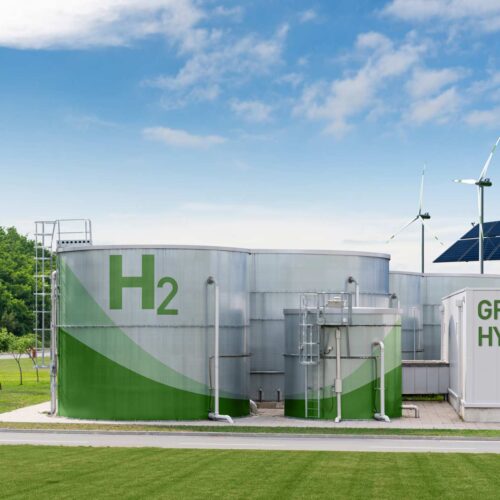The concept of clean Hydrogen Energy with icons, changing the CO2 fuel cell to H2 switching to clean hydrogen energy with friendly and sustainable development for environment and alternative lifestyle

Three Considerations to Make Green Hydrogen a Reality in India
When developing a green hydrogen project, the project configuration can determine its economic feasibility.
Amid global uncertainties in the hydrogen sector, India is emerging resilient, moving from hype to a more realistic outlook. As India focuses on achieving net-zero emissions, green hydrogen presents a transformative solution for its energy security and decarbonization goals. India’s vast renewable energy potential and industrial base position it as a key player in the emerging global green hydrogen economy.
The price of green hydrogen will ultimately decide if green hydrogen can graduate from the promises of pilot projects to large-scale developments. Recent tenders awarded by IOCL and HPCL, with winning bids ranging from US$ 3.73 to US$ 3.83 per kg (without GST) by L&T and Ocior Energy, illustrate optimistic price benchmarks that the market has set. However, other bids have reached as high as US$ 6 per kilogram, underscoring the variability in cost structures. Additionally, the Solar Energy Corporation of India recent green ammonia reverse auctions under the SIGHT scheme have discovered a record-low levelized cost of ammonia between US$583 and US$641 per ton, which approximately translates to a hydrogen cost of US$2.98 to US$3.28 per kg, underscoring the rapidly improving cost viability
Industrial leaders acknowledge the immense potential of green hydrogen; however, project configurations and final production cost vary significantly based on factors such as the availability of renewable energy, pricing, subsidies, and other relevant considerations. Moreover, project decisions are influenced by strategic choices such as prioritizing battery or hydrogen storage, system utilization efficiency, and potential additional revenue streams.
A recent RMI study examined five distinct project configurations across 17 states in India, offering insights into how these choices and considerations impact the final production costs.
1. Near-term competitiveness hinges on subsidies and waivers; a decline in system costs will be critical for the long term.
Stand-alone green hydrogen projects represent some of the most cost-competitive arrangements for hydrogen production, with costs ranging from $4.40/kg to $4.80/kg. Several states, including Maharashtra, Uttar Pradesh, and Odisha, offer capital subsidies ranging from 25 to 35 percent, which can further reduce the cost by approximately 20 percent.
However, the cost gap between green and grey hydrogen remains substantial, varying from $1.6/kg to $3.2/kg.
Key factors in incentivizing green hydrogen production include the scale and duration of subsidies, which directly influence final production costs. State-specific reductions due to waivers and incentives vary widely, with discounts ranging from just 1 percent in one state to 60 percent in another. Advancements in technology and economies of scale are expected to influence production costs by 2030 significantly.
Across the 17 states studied, the average cost of renewable power is projected to decline by 30 percent in 2030, playing a crucial role in reducing the cost of producing green hydrogen. By 2030, the cost of producing green hydrogen is projected to decrease 46 percent, from approximately $4.40/kg to $2.40/kg. This reduction will be propelled by lower renewable energy costs, advances in electrolysis technology, and increased infrastructure development, ultimately enhancing India’s competitiveness in the global green hydrogen market.
2. Choice considerations in project development offer flexibility to the developer.
The cost of producing green hydrogen primarily depends on the project configuration decisions made by developers. One of the key priorities for developers is maximizing system utilization. This approach aims to minimize the system size, thereby reducing the capital investment required for electrolyzers. However, maximizing system utilization also necessitates oversizing upstream renewable energy generation and hydrogen storage to ensure a consistent production flow.
For instance, increasing utilization from 25 to 75 percent could result in a reduction of more than 30 percent in production costs. However, beyond this optimal utilization level, the gains become marginal and are offset by the need to oversize renewable energy systems and hydrogen storage, resulting in increased capital investment.
In the long run, prioritizing maximum system utilization over optimal efficiency could lead to diminishing returns. As electrolyzer costs decline, the need to minimize capital investment in electrolyzers will be less critical, reducing the need to oversize systems in pursuit of higher utilization.
Consequently, oversizing the system also leads to excess generation, which, if not harnessed, could result in curtailment losses. The excess generation across modeled scenarios could range from 25 to 45 percent, depending on geographic renewable potential and project configuration. By capitalizing on this excess generation in the spot power market, developers could reduce production costs by 15–30 percent across states.
When planning green hydrogen projects, developers can also optimize for battery storage, hydrogen storage, or a combination of both, which can significantly influence project size.
Battery storage theoretically enables up to 100 percent utilization, which reduces the electrolyzer size to 610 MW for a 100 kiloton/year project. However, this would require more than 7 GW of oversized renewable energy (solar and wind) capacity. In contrast, hydrogen storage supports around 33 percent utilization, requiring a larger electrolyzer (approximately 1.9 GW) but just 3 GW of renewable capacity.
The choice between battery storage, hydrogen storage, or a hybrid approach offers flexibility to developers based on their business models. An optimized green hydrogen project would likely involve a strategic combination of both storage types, balancing operational flexibility, cost-effectiveness, and resilience.
3. Without offtakes, no project configuration can scale.
While the insights into project configurations help optimize the structure, no project configuration can scale without reliable offtakes. Offtake agreements — whether for domestic supply or early exports — are essential for providing the market certainty that allows developers to justify large-scale investments. However, securing these agreements remains one of the most significant challenges.
A significant issue is the lack of established, robust demand for green hydrogen within India’s domestic market. While industrial sectors such as steel, fertilizers, and refining show potential, the market remains in its infancy. Many players are hesitant to commit without clear policy and regulatory support. Additionally, the absence of a comprehensive green hydrogen trading framework, including long-term contracts, further hampers market development.
For early-stage exports, geopolitical factors, global trade policies, and certification standards present additional hurdles. Export agreements often require alignment with international standards, which many countries, including India, are still in the process of developing.
The way forward
Unlocking the scalability of green hydrogen projects requires efforts to create a stable demand environment. Enhancing market incentives, establishing reliable long-term offtake agreements, and de-risking investments will be critical. As the green hydrogen ecosystem evolves, creating reliable offtake mechanisms will foster investor confidence, stimulate market demand, and ensure that India’s green hydrogen sector reaches its full potential — both domestically and globally.


